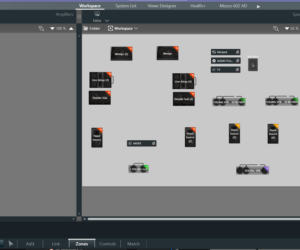Anya is not simply a loudspeaker system. It is the embodiment of a new concept: Adaptive Performance. Engineered to be capable of generating virtually any three-dimensional wavefront surface, each Anya module packs 22 transducers that are independently driven by 22 amplifier channels and 22 channels of DSP.
Although complex, using Anya is straightforward. Anya columns hang straight, allowing out fill arrays to hang adjacent to the mains. Resolution software generates DSP parameters to simultaneously adapt the wavefront surface and optimize the system frequency response to match the requirements of any venue within minutes.
Anya combines almost all major aspects of EAW technology – and many new ones – into a comprehensive, adaptive system that can meet most large-scale sound reinforcement applications. This result is the answer to questions we started asking over a decade ago with the design of the DSA series.
The questions: Could we create a system that would deliver an optimal three dimensional solution, one that could truly adapt to most sound reinforcement environments? Could we create a system that would give designers control without constraints? Could we create a system that would significantly reduce setup complexity and time?
The answer to all three of these questions, we found, was “yes.”
Acoustical Advantage
Our goal was to change, or better control, the vertical directivity and eliminate the need for down fill or angling the physical array. In order to significantly alter the shape of a wavefront without negatively impacting the impulse response, we needed to achieve very high resolution and discrete control of every device. This allows the relative change between adjacent devices to be small while the overall impact to the entire surface of the array is large.
Beginning with the low-frequency subsection, we determined that a horizontally-spaced 2 x 15-inch design would be optimal for several reasons. First, the diameter of a 15-inch woofer, combined with a carefully matched crossover frequency, offered the granularity we needed while also providing the “punch” demanded by a top-of-the-line system. The lows needed to complement the mid- and high-frequency elements and extend horizontal pattern control as far into the bass region as possible, while also maintaining an efficient truck pack.

About five years ago, we developed a 10-inch woofer for the KF740, probably the first woofer that used a split-winding coil design that allowed for a very linear BL Curve over wide excursion. Due to the exceptional low frequency capabilities this woofer affords, we decided to bring it to a larger 4-inch coil, 15-inch woofer. It uses a 32-mm coil winding with +/- 12 mm linear travel range, which we’ve not seen in a 15-inch woofer. The neodymium magnet structure provides high BL for strong impact while keeping weight to an absolute minimum.
Armed with the right low-frequency component, these woofers were loaded into the cabinet in an offset manner to retain optimum cabinet size and allow for an effective truck pack, while also giving us correct aperture spacing for ideal horizontal pattern control. The proprietary Offset Apertures are strategically placed several inches wider than the actual transducer spacing. This not only extends the uninterrupted surface of the horn, but also pushes the apparent origin of the low frequency sources farther apart. The net result is a design that delivers optimal and consistent horizontal directivity for an enclosure of this size.
Once the dual-15-inch LF section and general cabinet dimensions were defined, we were able to design precisely matched mid- and high-frequency sections. Keeping to the goal of high device resolution needed for Adaptive Performance and building upon what was learned with products like DSA, 1-inch HF spacing was a known design parameter – meaning the HF device itself had to be quite small, yet offer the required high output capability.















